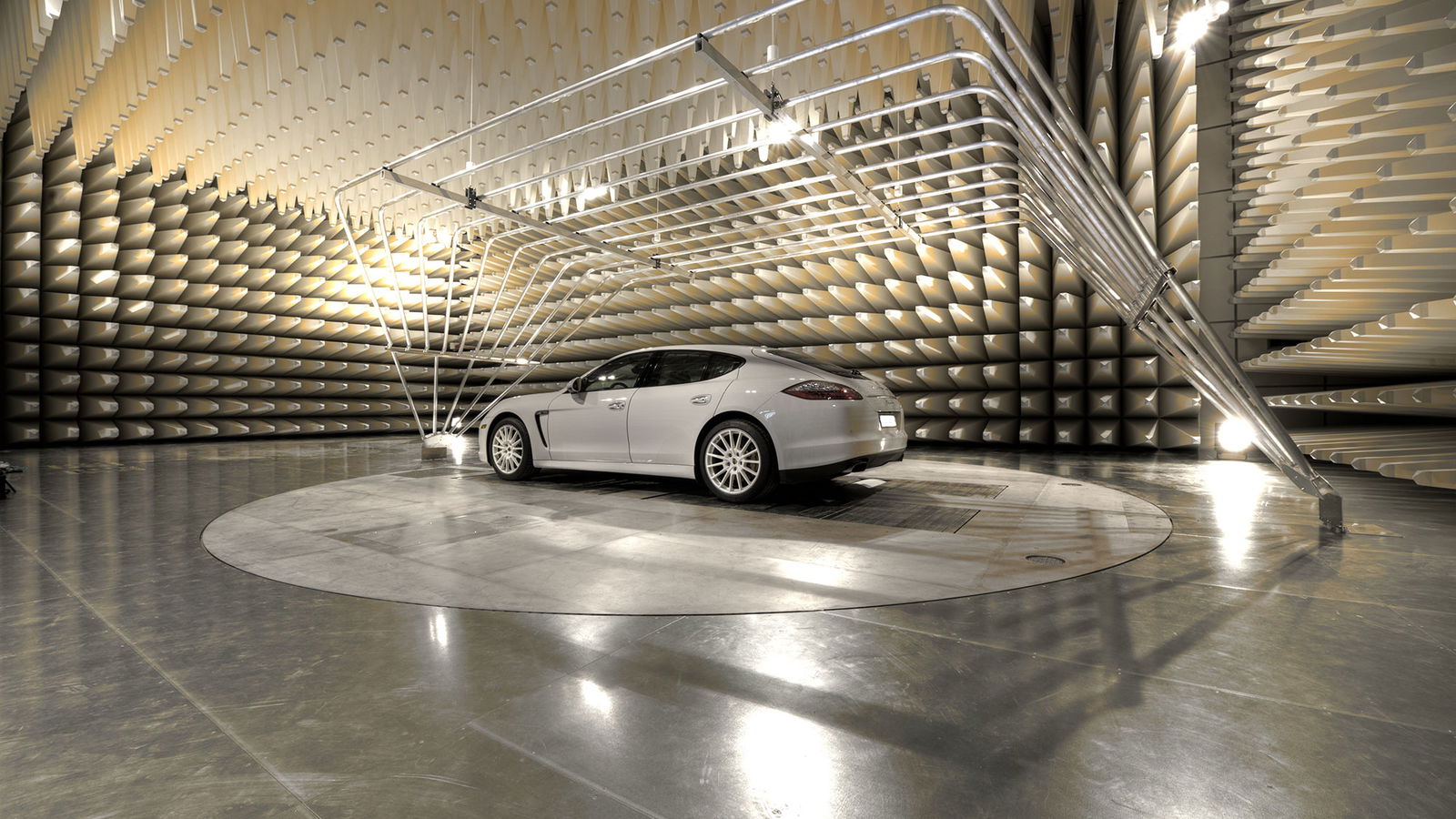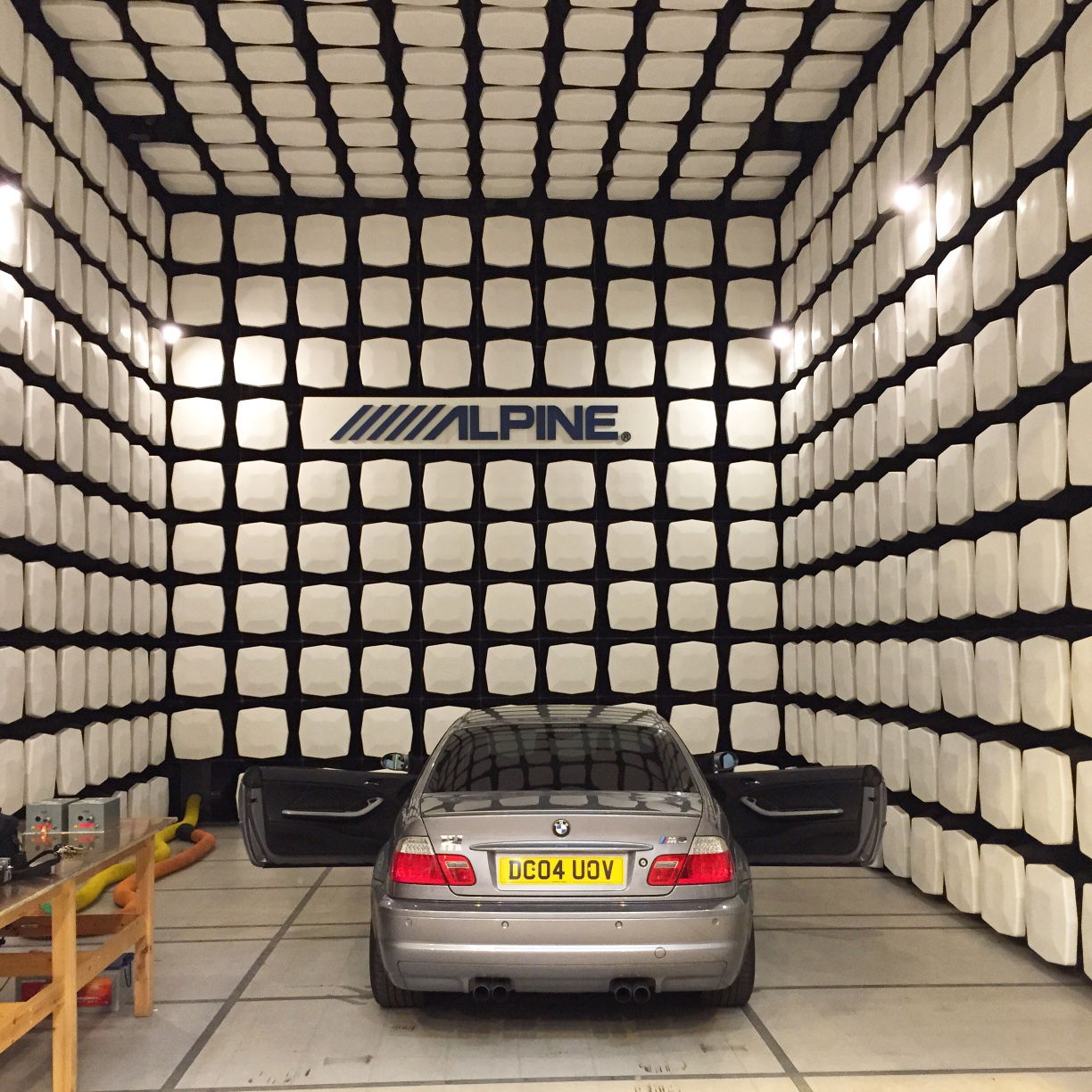What Is An Anechoic Chamber, And Why Are They So Important To The Car Industry?

Cars make a lot of noise. Even electric cars, that seemingly whizz about silently, will have a distinct sound - and every sound your car makes has probably been analysed, checked and tweaked to perfection. Manufacturers will check everything from the sound of the engine to the noise a door makes when it shuts; luxury cars always have a distinctive, expensive-sounding thud on closing the door. This is not a coincidence.
So how are these sounds checked? That’s where odd-looking rooms like the ones you see in the pictures here come in. They have varying names, but pretty much all of them work off the principal of an anechoic chamber. An anechoic chamber is essentially a soundproof room which limits the reflection of soundwaves in order to provide the cleanest possible environment to hear noises.

To simplify this massively, here’s how it works: the walls of a room are covered in foam shapes (usually some form of triangle, however depending on the frequencies you wish to nullify, the shapes can change) which absorb the sound waves. Thanks to the material these shapes are made from, sound does not reflect readily, while the shapes are designed to reflect any noise that does escape towards each other, rather than back into the room. This allows the walls to absorb sound, meaning recording equipment will not pick up on any external noises that may interfere with what’s being measured.
You may have heard of car manufacturers talking about NVH. That’s noise, vibration, and harshness, to you and I. It’s an important aspect of building a car, as any shakes and rattles will lower the perceived value of a car hugely. Therefore, by using these chambers, manufacturers can more readily isolate any unwanted noises.
There are a wide variety of different chambers that allow different objects to be recorded, with semi-anechoic chambers often used in the car industry - these are so-called because a heavy car would damage a fully anechoic chamber’s floor, so a semi-anechoic room will have solid flooring. For recording an engine under load, there are chambers with rolling roads inside, which allow for a more controlled environment for listening to a car at speed. A row of microphones allows technicians to simulate what a car sounds like while driving past.

Another form of anechoic chamber is an electromagnetic compatibility chamber (EMC). These do not measure audio, rather the electromagnetic fields emitted by electronic devices. You may have seen cars within such chambers after having audio equipment fitted; Adnan recently visited the guys at Alpine to get a new CarPlay headunit installed, and its guys popped the car in an EMC chamber to check the unit.
The building of a car is, obviously, an incredibly complex and time-consuming process, and it’s always fascinating to learn more about what goes on behind the scenes. So next time you shut your car door, listen up and remember that a team of people stood around an anechoic chamber and decided that that noise was acceptable!
Comments
Chrysler clearly doesn’t use one according to the squaks and rattles inside my 300C.
Ever been inside one? Scariest place you will ever visit, it’s so quiet, you can hear the blood in your veins and arteries, if you turn away from someone, you can’t hear them. Everything feels so close and claustrophobic, it is like being in a nightmare with no antagonist. And people work in these for hours at a time
Please keep these up!!!
i wanna move to an anechoic chamber to get away from everybody that isn’t into cars
The only time somethings not rattling, shaking, or vibrating in my C/10 is when the engine is off. You can’t even see through the side mirrors at highway speed. But I wouldn’t trade the driver experience in that piece of junk for the world.
Got a anechoic and a reverberation room where i work. We put plane doors and windows, cars and concept cars. It’s pretty cool to see what they do with microphone everywhere etc…
I took out the rubber thing that insulates the firewall for wires to pass through, just behind the turbo so I can hear that thing spool every gear.
I can no longer have a phone conversation on the road with my hands free head unit, but it’s worth it.
One of my favorite things to do is to compare the sound and required force of closing doors. So far, nothing has beaten a Bentley for closing more elegantly and authoritatively.
Anechoic chamber with a rolling road? Someone put a 4 rotor rx7 in there asap!
All of depicted pictures are EMC chambers. Apart for the obviously stated Alpine chamber, the other two have pyramids with their tops made of different materials for better EM damping in certain frequencies. Sound absorbing chambers usually have alternating horizontally and vertically aligned pyramids/wedges/polyhedrons. Other than that, a quick google search for images in this post revealed that information, which means the “unnecessary” information was simply left out.
https://acousticengineering.files.wordpress.com/2013/07/anechoic-6.jpg
Although I believe they are developing the sound of a car throughout the certain development process, it is not a process that starts from the beginning. Most of the sound comes from the exhaust system and can be easily adapted.
The EMC part of the story, however, is completely different and we must take the EMC into account from the very beginning. Which resistor, capacitor, inductor, which values. And these are only the three most simple electronic elements, without even considering complex integrated circutry.
Honestly, I am very disappointed with the subliminal and misleading article on the anechoic chamber with the sole focus on the sound, with so little addition of the EMC info.
In engineering it is the complete opposite.
Do not get me wrong and please consider this as a constructive criticism. If you bring the information to the public and people who like cars in the first place, do not steer them wrong. Try to cover all aspects of the topic and make a few phone calls to the companies that have something to do with such things. Do not diminish engineer work as granted, only as an information that somebody does that. Installing a radio inside a car and “popping” it inside an EMC chamber was not only to check that the radio functions correctly. It is also important that the vehicle functions correctly with the new part installed. Most of the time the source of the disturbance/interference will be the “car itself” and will influence the radio, which will be the susceptible device.
We engineers always love to talk about what we do, even when we have to be superficial because of the NDAs.
I would be glad to provide a deeper insight into EMC, even environmental testing. You know, the tests where you i.e. need to test your lights against all the weather effects and similar.
Have a nice day, morning, evening!
Pagination